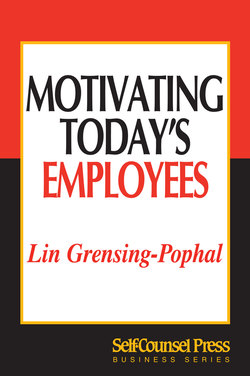Motivating Today's Employees

Реклама. ООО «ЛитРес», ИНН: 7719571260.
Оглавление
Lin Grensing-Pophal. Motivating Today's Employees
MOTIVATING TODAY’S EMPLOYEES
Introduction
Part I. THE BASICS OF MOTIVATION
1. Motivational Theory
What is motivation?
What the theorists tell us about motivation
Frederick Herzberg
Maslow’s hierarchy of needs
Theories X and Y
Theory Z
Applying the theories
2. Facts and Fallacies about Motivation
Fallacy #1: Motivation is the Goal
Fallacy #2: Money Motivates
Fallacy #3: The Golden Rule Applies
Fallacy #4: Motivators are Universal
Fallacy #5: The Burning Platform Can be a Strong Motivator
Fallacy #6: Motivation Doesn’t Matter As Long As the Job Gets Done
Fallacy #7: In a Poor Economy, Motivation Doesn’t Matter
Fallacy #8: Nobody’s Irreplaceable
Fallacy #9: I Can Motivate My Employees
Fallacy #10: Once a Motivated Employee, Always a Motivated Employee
3. What Motivates Employees?
Motivators for the 21st Century
What Employees Want
Employee Commitment
Employee Retention
Finding Out What Your Employees Want
Sample 1: What Do Employees Really Want
Putting It All Together
Sample 2: Retention Risk Assessment
Part II. THE FIRST LINE OF INFLUENCE
4. Finding the Right Fit
Hire Right
Start Employees Off On the Right Foot
Welcome
Organization chart
Company and department objectives
Working conditions
Job responsibilities and job standards
Company standards
Introductions
Problems to avoid during orientation
Goals, Roles, and Reporting Lines
Goals
Roles
Reporting lines
Maintaining Ongoing Contact
5. Coaching and Counseling
“What Do You Expect from Me?”
Establishing job standards
Establishing clear goals
Additional considerations
Evaluating Performance: “How Am I Doing?”
Providing constructive feedback
Giving credit and praise for accomplishments
The importance of constructive feedback
Handling Problem Employees
Exercising positive discipline
Exit Interviews
Exit interviews should be a standard operating practice
Use an objective third party to conduct the interview
Conduct an in-person interview
Look for trends, not incidents
6. Communication
Communication: An Organizational Priority
It starts at the top
Preparing employees to hear the messages
Manager as role model
Communicating in an Environment of Change
Creating an environment for change
What You Should Tell Employees
Common Communication Problems
Hearing only what you expect to hear
Letting biases interfere
Semantics
Noise
Emotions
Non-Verbal Communication
Organizational Barriers to Effective Communication
A Three-Step Approach to Avoiding Miscommunication
Step 1: Verification
Step 2: Clarification
Step 3: Follow-up
Encouraging Two-Way Communication
Removing the risk
Responding to constructive feedback
Communication Vehicles
Rap sessions
Regular meetings
Grievance or suggestion system
Intranet forums
Open-door policies
Opinion surveys
Social gatherings
Creative Communication: Lessons From the Front Lines
Part III. PROGRAMS, POLICIES, AND PRACTICES
7. Benefits
Meeting the Needs of a Diverse Workforce through Flexible Benefits
Addressing Employee Work/Life Needs
Family first: A no-cost/low-cost benefit
Time off when they want it: pto programs
Meeting the Needs of Working Parents
The three o’clock syndrome, and what you can (and should) do about it
The child-care dilemma
Workers Without Children
Telecommuting
Little Things Mean a Lot
A Variety Of Benefits to Meet Employee and Organizational Needs
Communicating the Value of Employee Benefits
8. Recognition and Reward
The Simple Things
Problems With Awards
Rewarding Employee Longevity
Additional Resources
9. Involvement and Advancement
Decision Making: More Than a Managerial Prerogative
Encouraging Employee Involvement
“What Do You Think?”
Encouraging Employee Suggestions
Job Growth and Opportunity
What makes a job a good job?
Providing job growth
Job redesign
Job enlargement
Job restructuring
Job enrichment
Cross-training
Teambuilding
Succession Planning: Identifying Future Leaders
Identify what skills and competencies are needed
Make sure the direction comes from the top
Develop an acceleration pool
Additional Resources
10. Education and Training
Training Topics
Customer service
Technology
Interpersonal skills
Quality improvement
Technical skills
The Benefits of Employee Education
Types of Training
In-house training
Choosing outside training
The topic
Speakers
Sponsor
Level of the program
Handout materials
Format
Time/cost
Location
Computer-based training
Getting a Degree Online
Other Training Opportunities
Brown-bag lunches
Reading groups
Discussion groups
Special assignments
Mentoring
Community events
Training Pays
11. Health and Wellness Programs
Job Pressures Impact Health and Wellness
How Jobs Contribute to Stress
Creating a Low-Stress Environment
The Benefits of Health and Wellness Programs
Steps to an Effective Program
Employee Assistance Programs (EAPS)
Managers and EAPs
Conclusion
About the Author
Notice to Readers
Self-Counsel Press thanks you for purchasing this ebook
Contents
Отрывок из книги
In an economy with more people than jobs, employers tend not to worry a great deal about motivating their workers. But in an economy like that of the early 21st century, where skilled labor is scarce and jobs are plentiful, the ability to attract and retain qualified employees becomes extremely critical.
Employee turnover and the retention of valued employees were major problems in the late 20th century, according to a retention and staffing survey conducted by Manchester Partners International. The average turnover rate in the United States hovered at 15 percent. The costs associated with turnover can be high — generally 25 percent of the individual’s annual salary. Aside from the obvious costs of advertising for, interviewing, and training replacement staff, there are more subtle costs, such as the impact of turnover on customer service and productivity.
.....
Achievement. This might involve learning new things or taking on new responsibilities.
Recognition for achievement. Recognition could entail pay increases, but it also includes less tangible forms of recognition, such as praise from management and colleagues, awards (certificates, plaques, an article about the employee in the organization’s newsletter, etc.).
.....